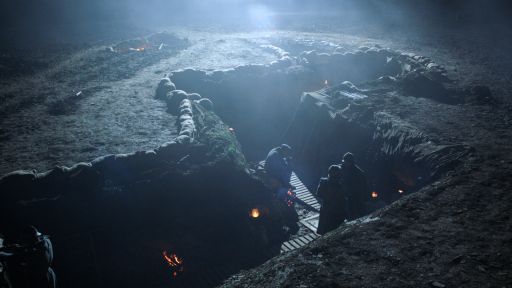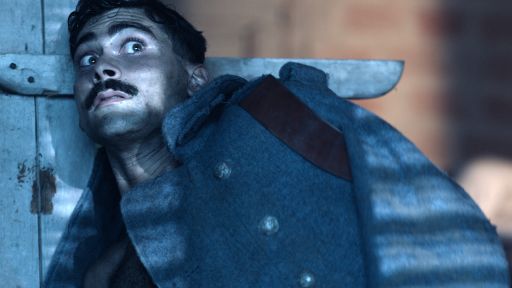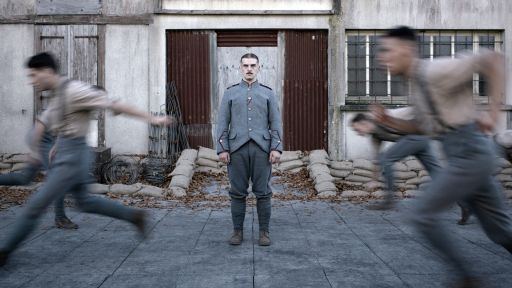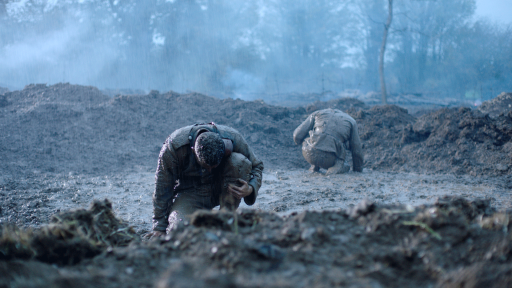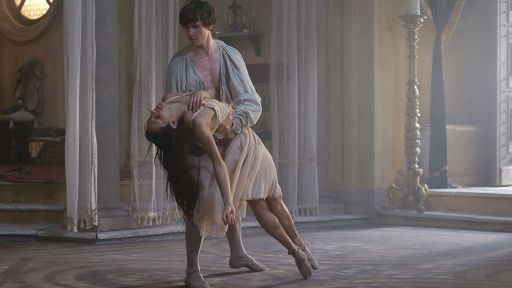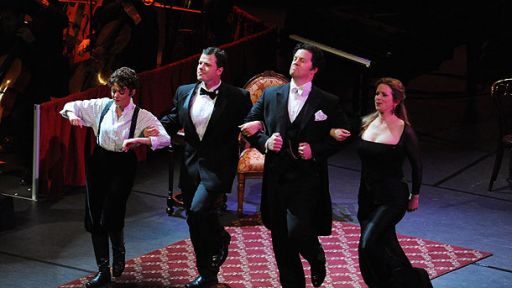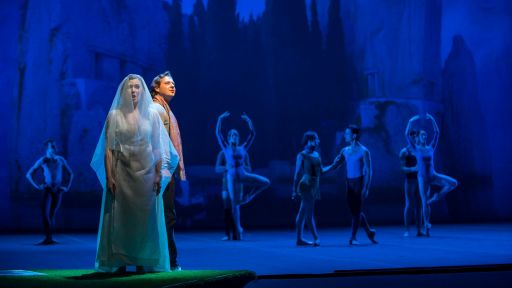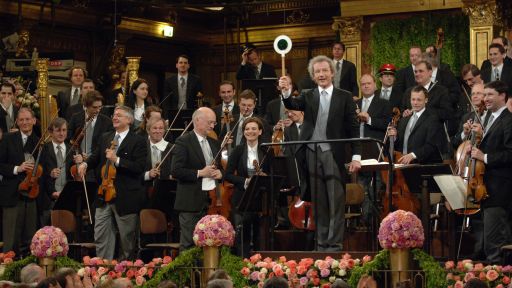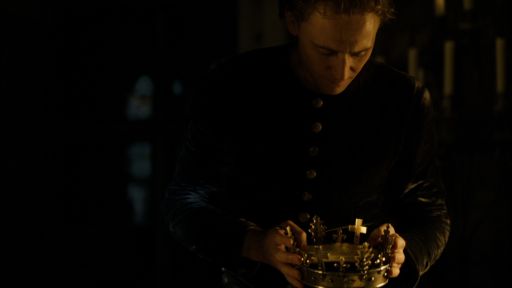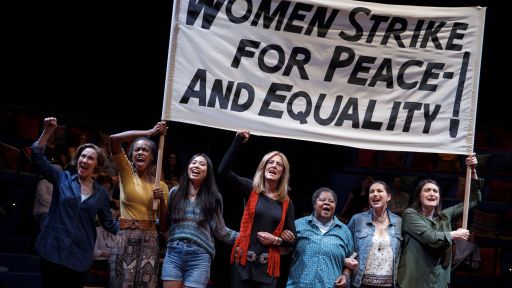The Great Performances team spoke with BalletBoyz Artistic Directors William (Billy) Trevitt and Michael Nunn about the making of Young Men. This interview is an extension of the above 14-minute “behind the scenes” look into the making of the film. Young Men, a World War I-inspired feature-length dance film commemorating the Great War’s centennial, comes to Great Performances Friday, April 7 at 9PM on PBS. Young Men was filmed on location in Northern France with the BalletBoyz dance company.
Please tell us more about the decision to make the war scenes and soldiers generic – as opposed to portraying a certain country’s soldiers in particular battles.
BILLY TREVITT: There are several reasons for that. One of them is that in the original theatrical work – the stage theater work – was much more abstract. It was more generally about war and soldiers but not specifically about a particular period in time. So when we translated it to film we knew we wanted to choose a particular moment in time, but not to be kind of panicking all the time about historical perfection – you know, have we got everything accurate and correct. That was one reason. Another reason is that we wanted it to feel more general – not about one either real life story or invented story, but more open for you to project your own thoughts on what you were seeing. So it was a combination of avoiding charges of historical inaccuracy, but also more importantly – wanting to leave the audience a little space to think.
Related to the previous question, can you please speak a bit about the multiple sources of inspiration behind the costumes? Were you involved in that process with Katherine Witt [costumer designer] at all?
BILLY TREVITT: We worked very closely with Katherine [Witt, the costume designer]. We were really keen in the same vain to put you in the right period, but you weren’t clear which side you were looking at. Whether you were goodies or badies, or a particular army at a particular moment in the first World War. But we wanted the feel to be of that period. And so we went through lots of reference books, photographs from the period, a book of historical costumes, a whole range of different things from films to propaganda… and chose elements of costumes that we thought were clearly of that period but didn’t feel quite so specific to a particular army. And so as she said in the film we ended up with – as she said in the film – Belgian uniforms and helmets but we changed the insignias. We made our own buttons. We changed the tailoring of the jackets and mixed different nationalities hats and so on. So really, an amalgamation of lots of different costume/uniform elements. The basis of them were French and Belgian uniforms that you can buy as ready made. So we started with that as the kind of setting for everything and then we started working on the tailoring and the piping and the stitching and the badges and buckles, and adding different things. So it all came from you know, one original source and then was played with until we felt it was giving us what we wanted.
Let’s talk about the film’s style of dance/ballet. It was very different from traditional ballet. It was very intense, and involved improvisation. Can you talk about the decision to use this style of choreography?
BILLY TREVITT: The choreographer worked very much with improvisation. So he would set a task, that for example, that would be asking all the 10 dancers to help him imagine different ways of taking the idea of being on a training ground and repetitive strength building, endurance building exercises. And what would they look like tweaked in such a way that they become dance moves or repeatable moves. So they spend a lot of time improvising and filming the improvisation and editing down that process until they end up with moves that are clearly dance and yet are really evocative of whatever the situation is – be it on the training field or the two guys in the crater filled with water. Refined movements that reflect back the emotion that we’re trying to portray. All the different characteristics of the performers and the storyline that they’re following. It’s not ballet at all, it does come a lot from contemporary dance, contact improvisation tasks. And I think the advantage to that for us is that once you go down that route, there are no rules – we can keep going until we get it right. If we were trying to tell the story with the five balletic positions then we may have struggled a little more and perhaps would have resorted to kind of old fashioned ballet mime. But that really wasn’t what we were trying to do at all. We were trying to tell a story by the combination of characters and how they moved.
World War I influenced the setting of Young Men, but the film was meant to touch upon experiences that all soldiers and veterans can relate to. How did you balance this?
MICHAEL NUNN: It was tricky actually, and the boys did quite a lot of research on WWI and the soldiers. But quickly, when we’re in the studio with no costuming and we’re not in the trench and we’re sort of shooting a map of the film in the studio, you start to realize that this is about all wars and all men that fight. WWI for my young guys is a long way away from them. So it’s much easier for them to look at more recent photographs and films of battles and soldiers. Especially for something like “Shell Shock” and the sort of mental anguish that these soldiers go to before battle and after battle, I think is interesting and poignant for them. And there’s that notion…the whole notion of WWI. It was mainly this waiting game… you didn’t really get that much contact with the enemy. It wasn’t the same as WWII. These guys spent a lot of their time bored to death in these trenches in these hideous conditions with this faceless enemy. And so we tried to delve into how that might feel. These days off…and we did quite a bit of research. And in the older films, you see these men and obviously they’ve got a camera on them but they’re smiling. And there’s just this pure joy of being away from the front for a few days. They might be on the front for a month or a month and a half and then they might be pulled back for a day or two days and there’s just this strange elation that they’re still alive. And the boys really got into that side of it. I mean I’m still completely amazed every time I watch the film by the dramatic performances by the gentleman. They were fantastic. They’re dancers. They’re not actors. They tell the narrative with their bodies. But I just thought they showed tremendous ability in the sort of subtle portrayal of what those soldiers must have been going through. And I think, well I hope that it really comes across on the screen. And I think because the project took such a long time and they were so committed to it, the movement just lent itself to body memory. They didn’t really have to think about the movement once they got on set. And it was really about living and being those characters. And it was a tough time. It was a tough shoot to make. Pretty adverse conditions, and we did ask a lot of them. But I think it was worth it.
What were some of the every day challenges of filming a feature length dance film on location? How did the dancers train for this varied terrain?
MICHAEL NUNN: Luckily the boys had been doing the material for quite a while and I suppose as with most theater and dance venues, you have to tailor the dance to that particular venue. The stage might be smaller or it might be raked. Then asking them to put this movement into 4-5 inches of mud, is a whole different question. But I think they sort of relished in the fact that they changed the choreography in such a way. It made the movement more believable. They didn’t have to fake falling over or trudging through these elements. It was real. And we mapped through everything very carefully to minimize the risk of injury. But you never know in those sorts of situations. And we were using explosives and the boys had never used anything like that before. It was tiring as well because as a dancer you’re used to working slightly shorter days. And I suppose if you’re an actor, you’re mainly standing around on set saying some lines. With these boys, they’d be standing there maybe an hour and a half while the shot was being set up, and then they’d have to perform. And then they’d rest for an hour and a half, so that was quite grueling I think. To be able to switch it on and switch it off physically was tough for them. But they came through it.
I thought it was also interesting that because it was a silent film you were able to speak with the dancers and provide frequent instruction.
MICHAEL NUNN: It made a huge difference I think, to us. To try and get the spontaneity of the performances – it was really useful that Billy and I, in our heads, knew the scenes intimately. Billy was the DOP on the shoot and I was basically in a hut watching the monitors and trying to direct them with a megaphone. So since they’re so used to taking instruction, especially from us – you could manipulate them – the movie and the scene in front of you in real time. So the scenes by the lake – with the ladies that brings the eggs down to the lake for instance, I think we shot that maybe twice. Almost just a one take — with the boys not really knowing what was gonna come up next. So we would call out “Mark, now you attack,” or “Matt, now you hold the knife.” And that was really how that worked. I think rehearsing something like that with untrained actors – with dancers – would have been a huge error. Because dancers naturally analyze every movement they do. It would become very staged and sterile within moments. So the spontaneity of sort of doing that in an improvisational way was key. And same with the last scene as well with Matt and Bradley in that crater. We mapped that out maybe 15 minutes before the scene started. We knew what we wanted and we knew how we wanted the camera to work and the feeling we wanted to come across. We basically just talked them through it. It was the only way we could think of doing it because they’re long scenes and that would have taken a huge amount of times to get used to that environment and rehearse and rehearse and rehearse. So we just kept saying “repeat that move, do that move, hold him down for longer, okay now back off all against the side. Now slowly stand there, keep still, come around now and carry on.” So, exhausting and exciting in the same way.
Yes, certainly – it made for very believable movement. It reminds me of when the composer spoke to the musicians about playing ugly instead of playing perfectly.
MICHAEL NUNN: Yeah, that was a big step for them. That isn’t often asked. And Keaton is very much about the emotional content, not just of the notes, but how the notes are played. And he wanted to feel that the orchestra was struggling in the same ways as the artist. And I think that was a very strong idea.

